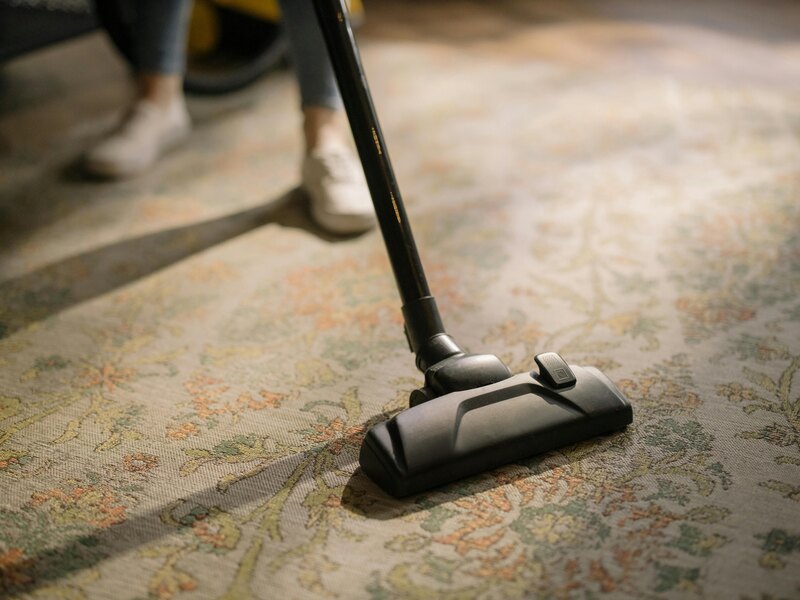If you’ve noticed holes in your carpet or strange small insects flying around, you may have a carpet moth infestation. These pests can cause significant damage to your carpets and other fabrics in your home. Therefore, it is important for you to know how to get rid of carpet moths.
In this article, we will explore what carpet moths are, how to identify them, the signs of an infestation, the damage they can cause, and most importantly, how to clean carpet moths from your home. Let’s dive in and learn how to tackle this common household problem!
What Are Carpet Moths?
Before going further into how to get rid of carpet moths, it’s good to know what carpet moths are.
Carpet moths, also known as textile pests, are common in the UK and are a nuisance for homeowners. These pests include Common Clothes Moths, Case Bearing Moths, and Carpet Beetles.
Carpet moths are particularly drawn to natural fibres such as wool and silk, which are commonly found in carpets and clothing fabrics. They are quite small and often go unnoticed until significant damage is done.
The life cycle of carpet moths consists of four stages: egg, larva, pupa, and adult. The larvae are the most destructive stage, feeding on the fibres of textiles and leaving behind silken trails and droppings.
How Do You Know If You Have Carpet Moths
One of the most common signs of a carpet moth infestation is the presence of small, irregularly shaped holes in your carpets. These holes are typically concentrated in areas where the larvae have been feeding on the fibres. You may notice patches of missing carpet fibres, giving the carpet a threadbare appearance.
Another indicator of a carpet moth infestation is the presence of moth larvae. These small, whitish larvae can often be found crawling on or near the affected carpets.
They are typically around half an inch long and may also leave behind silken tubes or casings as they move around. Here is a further explanation on how to identify the presence of carpet moths.
a. The Signs Of A Carpet Moth Infestation
Signs of a carpet moth infestation include visible damage to carpets, holes in fabrics, and the presence of moth larvae, indicating the need for immediate pest control measures.
- Visible damage to carpets: One of the first signs that your carpets might be infested by moths is the presence of irregularly shaped holes or chewed areas on the surface of the carpet fibres. These can vary in size but are typically small and scattered across the carpet.
- Holes in fabrics: Apart from carpets, check other fabric items such as rugs, upholstery, or clothing for small holes or patches of missing material. This is a common indicator of a carpet moth infestation spreading beyond just the carpets.
- Presence of moth larvae: If you notice small creamy white larvae crawling around your carpets or other fabrics, this is a strong indication that carpet moths have infested your home. These larvae can cause significant damage to your textiles if left unchecked.
To address these issues, it’s important to thoroughly clean and vacuum the affected areas, launder or dry clean infested fabrics, and consider using moth repellents or seeking professional pest control services to eliminate the infestation.
b. How Carpet Moths Damage Carpet
Carpet moths damage carpets by feeding on natural fibers like wool, silk, and fur, leading to holes, thinning areas, and visible tracks left by the larvae.
These pests are particularly drawn to areas of the carpet that are undisturbed and dark, making them a common nuisance in storage cupboards or under furniture.
Their larvae can cause substantial harm as they voraciously consume the fibers, weakening the structure of the carpet over time.
Once infestation spreads, the damage becomes more evident with patches of missing fibers and a sense of deterioration in the carpet’s overall quality.
What Attracts Carpet Moths?
Carpet moths are attracted to natural fibres such as wool and silk, and they prefer dark, undisturbed areas like cupboards and storage spaces for breeding and laying eggs.
These annoying little creatures are particularly attracted to areas with high levels of humidity, making damp cellars and lofts their ideal habitat. Their attraction to natural fibres is driven by the fact that they can easily feed and lay their eggs on these materials, sustaining their life cycle.Darkness provides them with the sense of security they need for their activities without being disturbed by light or human interference. The secluded locations they prefer grant them the privacy required to reproduce and thrive without external disruptions.
If you’ve noticed holes in your carpet or strange small insects flying around, you may have a carpet moth infestation. These pests can cause significant damage to your carpets and other fabrics in your home. Therefore, it is important for you to know how to get rid of carpet moths.
In this article, we will explore what carpet moths are, how to identify them, the signs of an infestation, the damage they can cause, and most importantly, how to clean carpet moths from your home. Let’s dive in and learn how to tackle this common household problem!
How To Get Rid Of Carpet Moths
Eliminating carpet moths involves various methods such as regular hoovering, using pheromone traps, applying insecticides, and freezing infested items to eradicate larvae and prevent further damage. Here is a further explanation of how to get rid of carpet moths that you can understand.
1. Vacuum Regularly
Regular hoovering is essential to remove carpet moth larvae, eggs, and debris from carpets and upholstery, reducing the risk of infestation and damage.
By diligently following a consistent hoovering routine, you can significantly minimise the chances of a carpet moth invasion taking root in your home. These pests are not only a nuisance but can cause considerable harm to your carpets and fabrics if left unchecked.
Hoovering not only eliminates existing eggs and larvae but also disrupts the environment conducive to their growth and reproduction, thwarting their life cycle. The mechanical action of the vacuum cleaner effectively sucks up these tiny intruders before they can cause significant harm.
To ensure thorough cleaning, pay close attention to areas where carpets meet walls, as well as underneath furniture and in dark corners where moths tend to hide their eggs. Utilise nozzle attachments and crevice tools to access these tight spaces that are often overlooked during regular cleaning.
Hoovering regularly not only eliminates existing pests but also prevents potential future infestations, making it a crucial practice in maintaining the health and longevity of your carpets and upholstery.
So if you’re wondering does carpet cleaning kill moths, then the answer is yes it can as long as you use the right deep carpet cleaning techniques.
2. Use Pheromone Traps
Pheromone traps are effective in monitoring and trapping adult carpet moths, disrupting their mating cycles and reducing the population in infested areas.
These traps work by releasing synthetic pheromones that mimic the scent of female moths, attracting males into the trap, where they become stuck and unable to mate.
Placement of pheromone traps is crucial for their effectiveness. They should be strategically placed near areas where moths are most active, such as cupboards, under furniture, or along skirting boards.
Regular monitoring of traps is essential to gauge the level of moth activity. Inspecting the traps weekly allows you to assess the effectiveness of your trapping efforts and make adjustments as needed.
Maintenance of traps involves replacing the sticky pads or lures as recommended by the manufacturer, typically every 6-8 weeks. This ensures that the traps remain attractive to moths and continue to capture them effectively.
3. Apply Insecticides
Applying insecticides specifically designed for carpet moths can help eliminate larvae and adult moths, reducing the population and preventing further damage to textiles.
Before applying any insecticide, it is essential to thoroughly vacuum the affected area to remove any eggs or larvae. Protective measures like gloves, masks, and eye protection should be worn to minimise exposure to potentially harmful chemicals. Ensure proper ventilation during application to avoid inhaling fumes.
When selecting an insecticide, opt for products labelled specifically for carpet moths. Read and follow the instructions on the label carefully, including dilution ratios and application methods. It’s advisable to treat all infested areas, including under furniture and along skirting boards.
4. Freeze Infested Items
Freezing infested items is a natural method to kill carpet moth larvae and eggs, effectively halting the infestation cycle and preserving textiles.
By subjecting the infested items to sub-zero temperatures, the extreme cold destroys the larvae and eggs without the use of harmful chemicals, making it an environmentally friendly pest control solution. Freezing helps protect delicate fabrics and materials from potential damage that could occur with other methods. This process is particularly beneficial for those looking for a non-toxic and safe approach to dealing with carpet moth infestations.
How To Prevent Carpet Moths
As you know how to get rid of carpet moths, it’s also good to understand how to prevent them.
Preventing carpet moths involves storing natural fibres correctly, maintaining a clean and clutter-free home environment, using essential oils as repellents, and regularly inspecting and treating carpets for signs of infestation. Find out the details below.
a. Store Natural Fibres Properly
Properly storing natural fibres in airtight containers or garment bags can prevent carpet moth infestations by restricting access to breeding grounds and food sources.
When selecting containers for storage, opt for materials like plastic or metal that seal tightly to ward off moth infiltration. Ensure the containers are clean and free of any moth larvae or eggs before placing the natural fibres inside.
It’s crucial to regularly inspect stored items for any signs of moth activity such as webbing or tiny holes. Implementing preventative measures like vacuuming carpets regularly, using moth repellents, and maintaining proper humidity levels can also help keep moths at bay.
b. Keep Your Home Clean And Free Of Clutter
Maintaining a clean, clutter-free home environment is crucial in preventing carpet moths, as these pests thrive in dark, undisturbed areas where debris and dust accumulate.
Regular hoovering and deep cleaning of carpets, rugs, and upholstery are essential in eradicating carpet moth eggs and larvae, disrupting their life cycle.
Regularly washing and airing out textiles such as curtains and bedding can also help in eliminating any hidden larvae or eggs that might be present.
Additionally, proper storage of clothing and natural fibre items in sealed containers or garment bags can prevent carpet moths from infesting your wardrobe.
c. Use Essential Oils As Repellents
Essential oils like lavender, cedarwood, and eucalyptus can act as natural repellents for carpet moths, deterring them from infesting textiles and fabrics.
These oils possess strong scents that disrupt the moths’ mating signals and egg-laying patterns, effectively keeping them at bay. Lavender, with its calming aroma, not only wards off moths but also promotes relaxation at home. Cedarwood is known for its insect-repelling properties, while eucalyptus has a refreshing scent that doubles as a moth deterrent. By diluting these oils in water and spritzing them onto carpets and cupboards, you create a natural barrier against moth infestations.
d. Regularly Inspect And Treat Your Carpet
Regularly inspecting and treating carpets for signs of carpet moths is essential for early detection and effective pest control, ensuring the longevity of your textiles and fabrics.
When conducting inspections, focus on areas where carpets are undisturbed, such as under furniture or along skirting boards, as moths prefer dark and quiet spots for laying eggs.
Look for telltale signs like small holes or silken tubes, and consider using a magnifying glass to spot tiny eggs or larvae. Vacuuming regularly can help prevent infestations by removing eggs and larvae.
Now you know how to get rid of carpet moths and the answer to does carpet cleaning get rid of moths. Ultimately, quick action is key if you suspect a moth infestation, as moths can spread quickly and cause severe damage to your carpet.
Therefore, ensure your carpets are free from nuisance pests and maintain a healthier home environment by choosing TEKA Cleaning’s professional carpet cleaning services.
Book now or give us a call on 01233 751 544 to schedule your appointment and safeguard your carpets from moths and other pollutants. Experience the difference in cleanliness and enjoy a healthier living space with TEKA Cleaning.
Read also:










